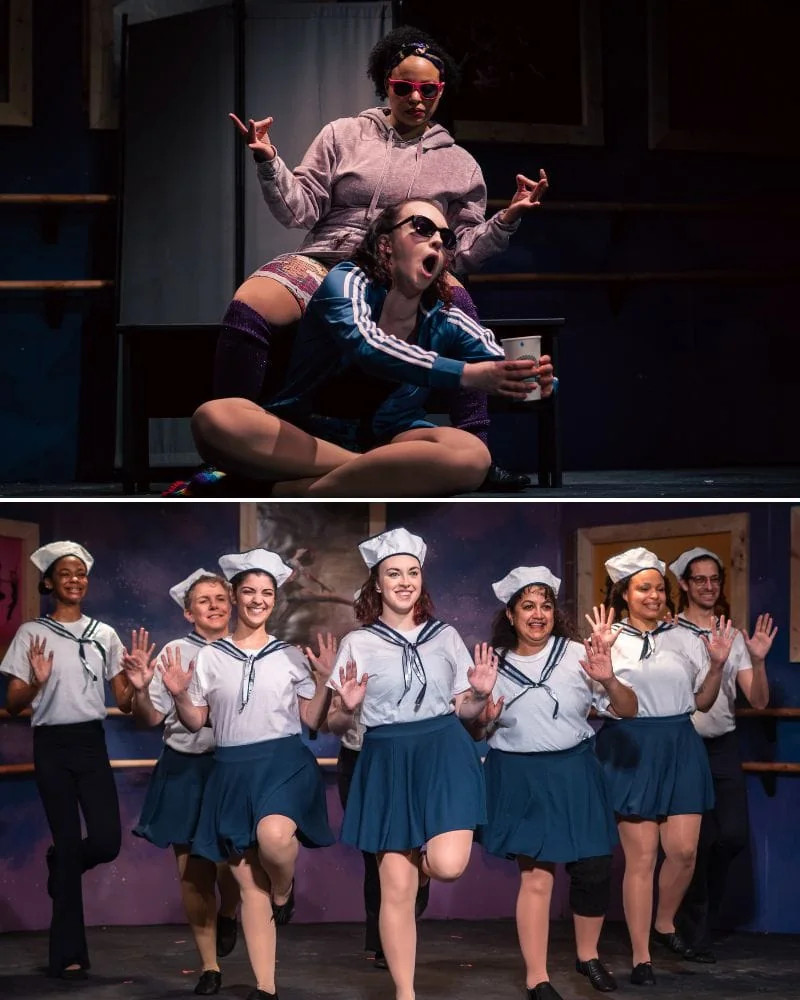Silver Spring Stage’s recent performance of Dance Nation made one thing undeniably clear: the intensity of competitive dance, once experienced, never truly leaves you. Clare Barron’s play, skillfully directed by Lee Blaser and produced by Liz Butterworth and Jim Robertson, offers a sharp and insightful skewering of the dance world. More profoundly, it delves into the complex, often bewildering, yet ultimately empowering and exhilarating journey from childhood to adulthood, particularly for young women. As a former competitive dancer myself, the play was instantly transportive, evoking vivid memories of a formative period in my life. I found myself thoroughly engaged, reminiscing and reflecting as I watched this uniquely entertaining and thought-provoking piece of theater.
Set in contemporary times, Dance Nation centers on a group of young dancers—girls, with a single token boy, a detail that perfectly captures the nuances of the dance world—as they prepare for and participate in a series of high-stakes competitions. The dance they rehearse and perform is described as an “acro-lyrical” piece, surprisingly themed around Gandhi. This number is choreographed and led by their intensely dedicated and dramatic “Dance Teacher Pat,” a character who, much like many dance teachers I’ve encountered, embodies an unwavering seriousness about the craft, expecting nothing less than complete and constant dedication from his students. Anderson Wells delivers a commanding performance as Pat, his portrayal striking a perfect balance between hilarity and uncanny accuracy. The production’s commitment to authenticity is truly impressive, evident in both broad strokes—like the archetypal overbearing dance mom—and subtle details, such as the dancers’ matching satin jackets and the lighthearted games they play before class and backstage at competitions. The adult actors convincingly embody the essence of 13-year-olds, capturing everything from their casual physical interactions while waiting for class to their awkward, nascent explorations of love, sex, and friendship.
 Boneza Valdez Hanchock and Tristin Evans in ‘Dance Nation.’
Boneza Valdez Hanchock and Tristin Evans in ‘Dance Nation.’
The play’s narrative unfolds primarily in the moments surrounding dance class or competitions, and it is within these interstitial spaces that Barron’s deeper message resonates most powerfully. Interspersed throughout the scenes are compelling monologues delivered by various cast members, offering raw, sometimes unsettling glimpses into their innermost thoughts, anxieties, and vulnerabilities. Boneza Valdez Hanchok’s portrayal of Ashlee is both vibrant and comedic; Ashlee grapples with a complex relationship to her own beauty and intelligence, initially intimidated but ultimately deciding to embrace her appearance and the power she perceives it to hold. Sia Li Wright’s Zuzu, portrayed with grace and talent, wrestles with self-doubt and the agonizing feeling that she is unable to evoke genuine emotion in those who watch her dance.
The central plot conflict emerges between Zuzu and her teammate Amina, positioned as the group’s two most talented dancers. Carlotta Capuano perfectly embodies Amina, striking a delicate balance between confidence and feigned modesty. Amina is a character instantly recognizable to anyone familiar with the competitive dance scene. She thrives in the spotlight, possesses the talent to command attention, and demonstrates the unwavering work ethic required to win—a drive that culminates in a pivotal scene near the play’s conclusion. While the surface narrative arc centers on the team’s potential journey to Tampa Bay for the ultimate competition, the true heart of the story lies in the intricate relationships between the girls (and the lone boy) and, perhaps even more importantly, their evolving relationships with themselves.
Tristin Evans delivers a compelling performance as Sofia, another dancer on the team. Sofia navigates the unfamiliar territory of her first period, initially horrified by her mother’s suggestion to “just look at it” as a way to learn how to use a tampon. However, when she finally finds the courage to look, she experiences a moment of empowerment, marveling at its unexpected beauty. Reflecting the play’s themes, audience members were offered kits from “The Growing Girls Project,” an initiative that began as a PhD dissertation by Dr. Ann Herbert at the Johns Hopkins Bloomberg School of Public Health. These kits, designed for individuals aged 8 to 16, include an activity book and a self-exploration mirror, aiming to “equip girls with tools to understand, connect with, appreciate, and respect their changing selves and bodies as they go through puberty.”
 Boneza Valdez Hanchock and Tristin Evans in ‘Dance Nation.’
Boneza Valdez Hanchock and Tristin Evans in ‘Dance Nation.’
Numerous elements of Dance Nation contribute to its raw and deeply personal atmosphere. The choreography by Michelle Norris and Tristin Evans feels authentic and age-appropriate, while Jeffrey Asjes’ minimalist yet immersive set design, combined with Jordan Hersh’s lighting, seamlessly transports the audience from a dance studio to the intimate space of “riding in mom’s car in the rain.” McKenna Kelly’s costume, prop, makeup, and hair design is so meticulously accurate, it feels as though she directly sourced items from my own childhood dance studio’s forgotten closet.
Dance Nation masterfully blends laugh-out-loud satirical moments that resonate with anyone who has spent time in a dance studio with moments of profound intimacy, bordering on discomfort, addressing themes like masturbation, self-harm, and first menstruation. The play intentionally evokes cringes of recognition as it presents these vignettes of puberty, but it simultaneously compels us to consider alternative realities—what might have been, or what could be in the future—if society fostered bodily understanding and compassion instead of shame and secrecy. Dance Nation suggests that embracing such openness could unlock a sense of unstoppable freedom.
Running Time: One hour and 40 minutes with no intermission.
Dance Nation is playing at Silver Spring Stage, 10145 Colesville Road, Silver Spring, MD, through March 24, 2024, with performances on Fridays and Saturdays at 8 pm, and Sundays at 2 pm. Tickets, priced at $23.25–$26.25 (including fees), can be purchased at the door or online. For further information, please call (301) 593-6036, visit the website, or send an email to [email protected].
Please be advised that this show contains mature themes including sexual content, frequent strong language, partial nudity, depictions of masturbation and abuse, themes of racism and stereotyping/tokenization in dance performance, suicide, and self-harm.
COVID Safety: Masks are encouraged but not required.
Dance Nation By Clare Barron Directed by Lee Blaser
CAST Amina – Carlotta Capuano Zuzu – Sia Li Wright Ashlee – Boneza Valdez Hanchock Connie – Leena Dev Sofia – Tristin Evans Maeve – Allison Turkel Luke – Brandon Rothenberg Dance Teacher Pat – Anderson Wells The Moms/Vanessa – Jordan Coscia The Moms/Vanessa – Rachel Manteuffel
Understudies/Swings Trenor Gould (Dance Teacher Pat, Luke) Nadine Pineda (Zuzu, Ashlee, Sofia)
Fight/Intimacy Direction by Julia Rabson Harris; Composition by Kristin Cotts; Stage Management by David Gorsline; Carpentry by Douglas Becker, Steve Leshin, and Steven Malone; Sound Design by Jeff Goldgeier.

